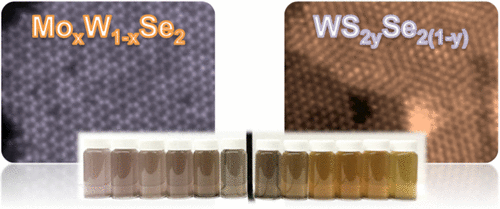当前位置:
X-MOL 学术
›
J. Am. Chem. Soc.
›
论文详情
Our official English website, www.x-mol.net, welcomes your
feedback! (Note: you will need to create a separate account there.)
Low-Temperature Solution Synthesis of Transition Metal Dichalcogenide Alloys with Tunable Optical Properties
Journal of the American Chemical Society ( IF 14.4 ) Pub Date : 2017-08-02 , DOI: 10.1021/jacs.7b04443 Yifan Sun 1 , Kazunori Fujisawa 1 , Zhong Lin 1 , Yu Lei 1 , Jared S. Mondschein 1 , Mauricio Terrones 1 , Raymond E. Schaak 1
Journal of the American Chemical Society ( IF 14.4 ) Pub Date : 2017-08-02 , DOI: 10.1021/jacs.7b04443 Yifan Sun 1 , Kazunori Fujisawa 1 , Zhong Lin 1 , Yu Lei 1 , Jared S. Mondschein 1 , Mauricio Terrones 1 , Raymond E. Schaak 1
Affiliation

|
Nanostructures of layered transition metal dichalcogenide (TMD) alloys with tunable compositions are promising candidates for a broad scope of applications in electronics, optoelectronics, topological devices, and catalysis. Most TMD alloy nanostructures are synthesized as films on substrates using gas-phase methods at high temperatures. However, lower temperature solution routes present an attractive alternative with the potential for larger-scale, higher-yield syntheses of freestanding, higher surface area materials. Here, we report the direct solution synthesis of colloidal few-layer TMD alloys, MoxW1-xSe2 and WS2ySe2(1-y), exhibiting fully tunable metal and chalcogen compositions that span the MoSe2-WSe2 and WS2-WSe2 solid solutions, respectively. Chemical guidelines for achieving the targeted compounds are presented, along with comprehensive structural characterizations (X-ray diffraction, electron microscopy, Raman, and UV-visible spectroscopies). High-resolution microscopic imaging confirms the formation of TMD alloys and identifies a random distribution of the alloyed elements. Analysis of the tilt-angle dependency of the intensities associated with atomic-resolution annular dark field imaging line scans reveals the types of point vacancies present in the samples, thus providing atomic-level insights into the structures of colloidal TMD alloy nanostructures that were previously only accessible for substrate-confined films. The A excitonic transition of the TMD alloy nanostructures can be readily adjusted between 1.51 and 1.93 eV through metal and chalcogen alloying, correlating the compositional modulation to the realization of tunable optical properties.
中文翻译:

具有可调光学特性的过渡金属二硫属化物合金的低温溶液合成
具有可调成分的层状过渡金属二硫属化物 (TMD) 合金的纳米结构是电子、光电子、拓扑器件和催化领域广泛应用的有希望的候选者。大多数 TMD 合金纳米结构是在高温下使用气相方法合成为基材上的薄膜。然而,较低温度的溶液路线提供了一种有吸引力的替代方案,具有用于独立式、更高表面积材料的更大规模、更高产率合成的潜力。在这里,我们报告了胶体少层 TMD 合金 MoxW1-xSe2 和 WS2ySe2(1-y) 的直接溶液合成,分别展示了跨越 MoSe2-WSe2 和 WS2-WSe2 固溶体的完全可调的金属和硫属元素组成。提供了实现目标化合物的化学指南,以及全面的结构表征(X 射线衍射、电子显微镜、拉曼和紫外可见光谱)。高分辨率显微成像证实了 TMD 合金的形成,并确定了合金元素的随机分布。对与原子分辨率环形暗场成像线扫描相关的强度倾斜角依赖性的分析揭示了样品中存在的点空位类型,从而提供了对胶体 TMD 合金纳米结构结构的原子级洞察,而这些结构以前只有可用于基材限制的薄膜。通过金属和硫属元素合金化,TMD 合金纳米结构的 A 激子跃迁可以很容易地在 1.51 和 1.93 eV 之间调整,从而将成分调制与实现可调光学性能相关联。
更新日期:2017-08-02
中文翻译:

具有可调光学特性的过渡金属二硫属化物合金的低温溶液合成
具有可调成分的层状过渡金属二硫属化物 (TMD) 合金的纳米结构是电子、光电子、拓扑器件和催化领域广泛应用的有希望的候选者。大多数 TMD 合金纳米结构是在高温下使用气相方法合成为基材上的薄膜。然而,较低温度的溶液路线提供了一种有吸引力的替代方案,具有用于独立式、更高表面积材料的更大规模、更高产率合成的潜力。在这里,我们报告了胶体少层 TMD 合金 MoxW1-xSe2 和 WS2ySe2(1-y) 的直接溶液合成,分别展示了跨越 MoSe2-WSe2 和 WS2-WSe2 固溶体的完全可调的金属和硫属元素组成。提供了实现目标化合物的化学指南,以及全面的结构表征(X 射线衍射、电子显微镜、拉曼和紫外可见光谱)。高分辨率显微成像证实了 TMD 合金的形成,并确定了合金元素的随机分布。对与原子分辨率环形暗场成像线扫描相关的强度倾斜角依赖性的分析揭示了样品中存在的点空位类型,从而提供了对胶体 TMD 合金纳米结构结构的原子级洞察,而这些结构以前只有可用于基材限制的薄膜。通过金属和硫属元素合金化,TMD 合金纳米结构的 A 激子跃迁可以很容易地在 1.51 和 1.93 eV 之间调整,从而将成分调制与实现可调光学性能相关联。


















































 京公网安备 11010802027423号
京公网安备 11010802027423号